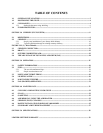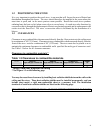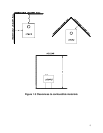
4
1.2 POSITIONING THE STOVE
It is very important to position the wood stove in an area that will favour the most efficient heat
distribution throughout the house. The stove should therefore be installed in the room where the
most time is spent, and in the most spacious room possible. Recall that wood stoves produce
radiating heat, the heat we feel when we are close to a wood stove. A wood stove also functions by
convection, that is through the displacement of hot air accelerated upwards and its replacement with
cooler air at the floor level. The stove’s convection effect is facilitated by the installation of a
blower.
1.3 CLEARANCES
Clearances to any combustibles when measured directly from the floor protector to the ceiling must
be a minimum of 84" (2134 mm). Clearances to any combustibles when measured directly from the
front of the stove must be a minimum of 48" (1219 mm). The stove must also be placed so as to
maintain the minimum clearances to combustible walls specified for each type of connector used.
See Table 1.3 below for all clearance measures
Clearances to combustible materials**
Table 1.3 Clearances to combustible materials
MODEL
BACK (A)
Single wall pipe / Double wall
SIDES (B)
Single wall pipe / Double wall
CORNERS (C)
Single wall pipe / Double wall
HEIGHT
(D)*
Escape 1800 14’’ / 6’’ 12’’ / 12’’ 7’’ / 5’’
*7' / 2,13
m
* Height, from floor protection to ceiling
**See Figure 1.3 on the following page
You may decrease these clearances by installing heat radiation shields between the walls or the
ceilin
g
and the stove. These heat radiation shields must be installed permanentl
y
, and can
include sheet metal, a rigid non-combustible sheet or a masonr
y
wall. The installation
standards of such heat radiation shields are listed on the following page.
IT IS STRICTLY FORBIDDEN TO PLACE WOOD WITHIN MINIMUM CLEARANCES


















